Explore the profound significance of biblical thanksgiving stories that have shaped faith and community, inviting reflection on their timeless relevance.
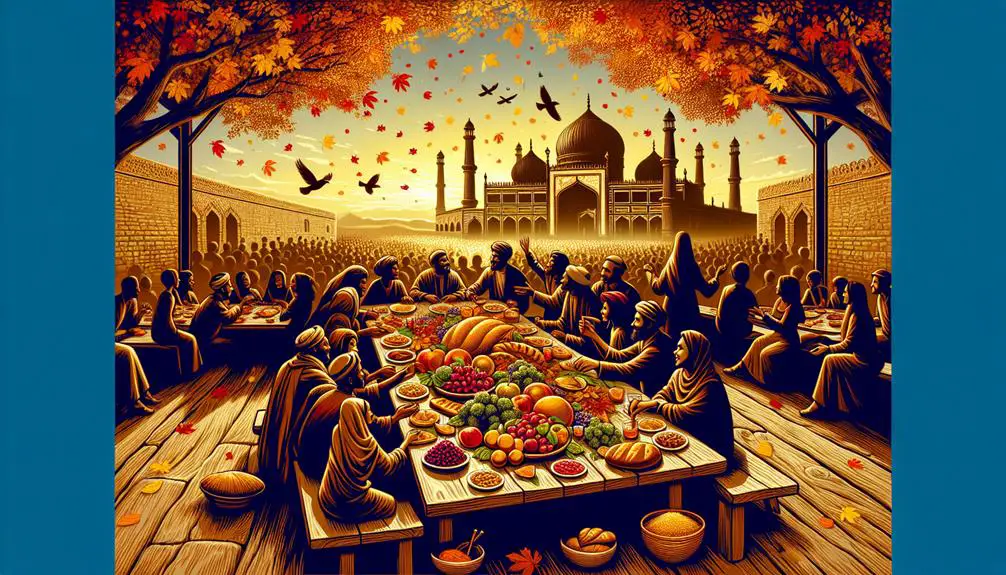
Story About Thanksgiving in the Bible
The concept of thanksgiving in the Bible traverses both the Old and New Testaments, embodying a rich tapestry of cultural and spiritual significance. From the First Fruits Offering, a symbol of trust and gratitude towards God's provision, to Paul's Letters of Gratitude that underscore the foundational role of thankfulness in Christian life, these narratives offer profound insights into the essence of giving thanks.
As we explore these stories, one cannot help but ponder the enduring impact of these acts of thanksgiving on the fabric of faith and community. How do these ancient traditions of gratitude resonate with us today?
Key Takeaways
- Thanksgiving in the Bible is deeply rooted in acts of faith, gratitude, and communal worship.
- Biblical stories highlight the importance of giving thanks as a way to acknowledge God's providence and blessings.
- Jesus' ministry emphasized gratitude through miracles and teachings, setting a model for Christian practice.
- Paul's epistles advocate for gratitude as a foundational element of Christian identity and community life.
The First Fruits Offering
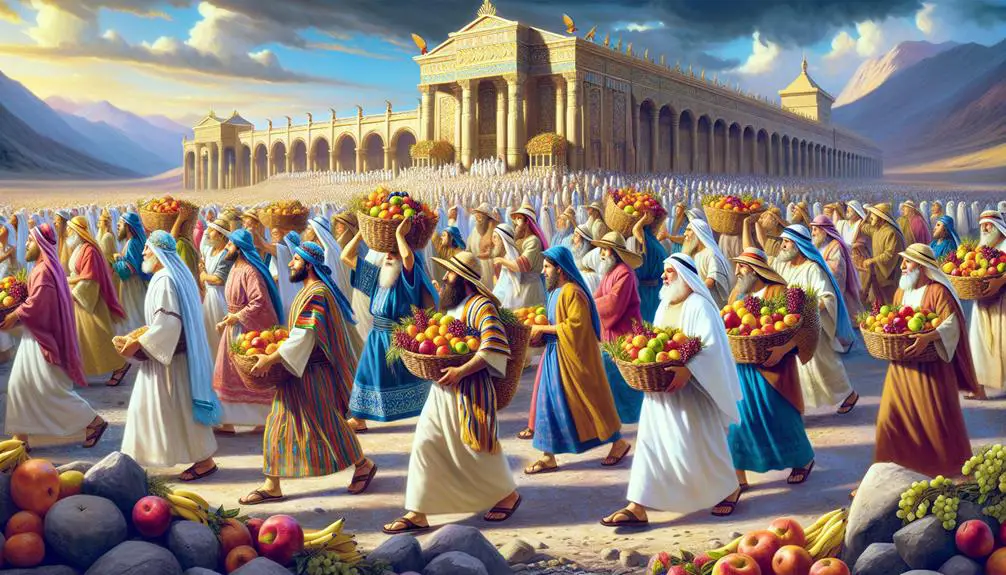
The concept of the First Fruits offering, deeply rooted in biblical tradition, represents a fundamental act of thanksgiving and faithfulness, wherein the earliest harvest of crops was dedicated to God as a symbol of gratitude and trust in His provision. This practice, enshrined within ancient Israelite culture, underscores not only a religious obligation but also a profound recognition of the agricultural significance that underpinned their society. Through this offering, the community acknowledged the cyclical nature of life and sustenance, deeply intertwined with the divine.
Analyzing the First Fruits offering in the context of harvest festivals reveals a broader cultural and spiritual landscape. These festivals, pivotal in the agricultural calendar, provided structured moments for reflection on the relationship between divine favor and the bounty of the earth. The act of offering the first harvest was thus not merely transactional but represented a moment of communal consecration and thanksgiving. It reinforced social cohesion and a collective identity rooted in a shared dependence on land and deity.
This offering also held agricultural significance beyond its immediate religious context. By dedicating a portion of the earliest harvest to God, the Israelites engaged in a practice that symbolized the renewal of the covenant between them and the divine. It was an acknowledgment that all produce, and by extension, all prosperity, originated from a power beyond their control. This act of faith and thanksgiving, therefore, served as a cornerstone for both spiritual life and agricultural practice, encapsulating a profound understanding of human dependency on divine providence and the rhythms of the natural world.
David's Song of Thanks
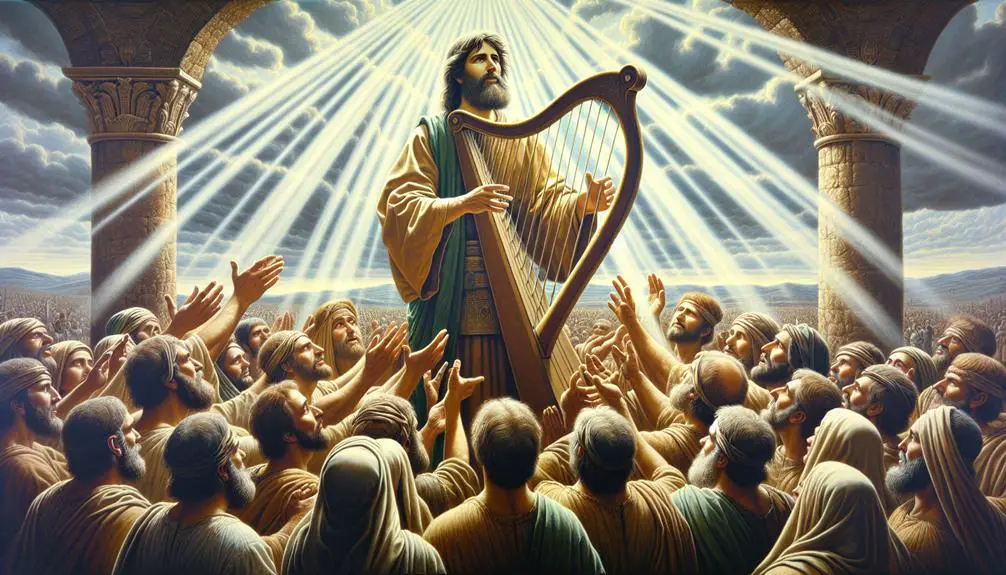
Reflecting on the tradition of the First Fruits offering as a foundational act of faith and gratitude, we now turn our attention to another profound expression of thanksgiving within the biblical narrative: David's Song of Thanks. This moment, chronicled in the scriptures, signifies not merely an individual act of worship but marks a pivotal point in the evolution of worship practices among the Israelites.
David's Song of Thanks, articulated upon the successful transfer of the Ark of the Covenant to Jerusalem, underscores the Ark's significance as a symbol of God's presence and favor. This event is a watershed in the religious life of Israel, highlighting a transition from nomadic worship practices to a more centralized form of worship in Jerusalem, thereby setting a precedent for future generations.
Aspect |
Description |
Relevance |
|---|---|---|
Ark Significance |
Symbol of God's presence and covenant with Israel. |
Centralizes worship, reinforcing communal identity and divine favor. |
Worship Evolution |
From itinerant tabernacles to a fixed sanctuary. |
Marks a shift in religious practice, emphasizing permanence and unity. |
David's Gratitude |
Expressed through music and public celebration. |
Demonstrates the intertwining of leadership, worship, and thanksgiving. |
Community Involvement |
Collective participation in bringing the Ark to Jerusalem. |
Highlights the communal aspect of thanksgiving and worship. |
Legacy |
Sets a precedent for future acts of worship and thanksgiving. |
Influences the construction of the Temple and subsequent religious practices. |
David's Song of Thanks, therefore, is not just an individual expression of gratitude but a seminal moment in the religious and cultural development of Israel, reflecting both the significance of the Ark and the dynamic evolution of worship practices.
Solomon Dedicates the Temple
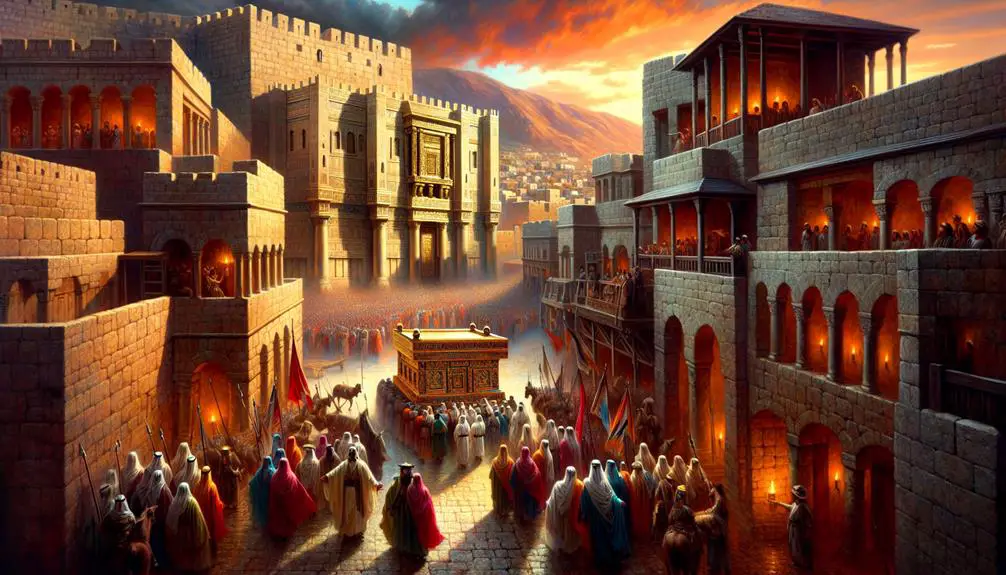
Building upon the foundation laid by David's Song of Thanks, Solomon's dedication of the Temple represents a culmination of religious and national identity through a grand act of worship and gratitude. The Temple's construction, initiated by Solomon, marks a pivotal moment in the ancient history of Israel, serving not only as a physical space for worship but also as a symbol of the nation's unity and devotion to God. This monumental effort underscored the importance of thanksgiving and reverence in the community's collective identity, setting a precedent for future generations.
The dedication ceremony itself, as chronicled in biblical texts, was imbued with profound sacrificial rituals, highlighting the depth of Solomon's commitment to God and the significance of the Temple as a sacred site. These rituals, involving an extensive array of offerings, were not mere formalities but served as a tangible expression of gratitude and submission to divine will. The sheer scale of the sacrifices, unparalleled in the history of Israel up to that point, underscored the magnitude of the occasion.
Furthermore, Solomon's prayer of dedication encapsulates the essence of thanksgiving within the context of the Temple's consecration. It is a reflective acknowledgment of God's steadfastness and mercy, a plea for continued divine presence and guidance. This act of collective thanksgiving, set against the backdrop of the newly constructed Temple, reinforces the integral role of gratitude in fostering a resilient and devout community.
In essence, the dedication of the Temple by Solomon is a multifaceted event that synthesizes architectural achievement, sacrificial rituals, and a profound sense of communal thanksgiving, thereby enriching the tapestry of biblical narratives centered around gratitude.
Jesus Gives Thanks
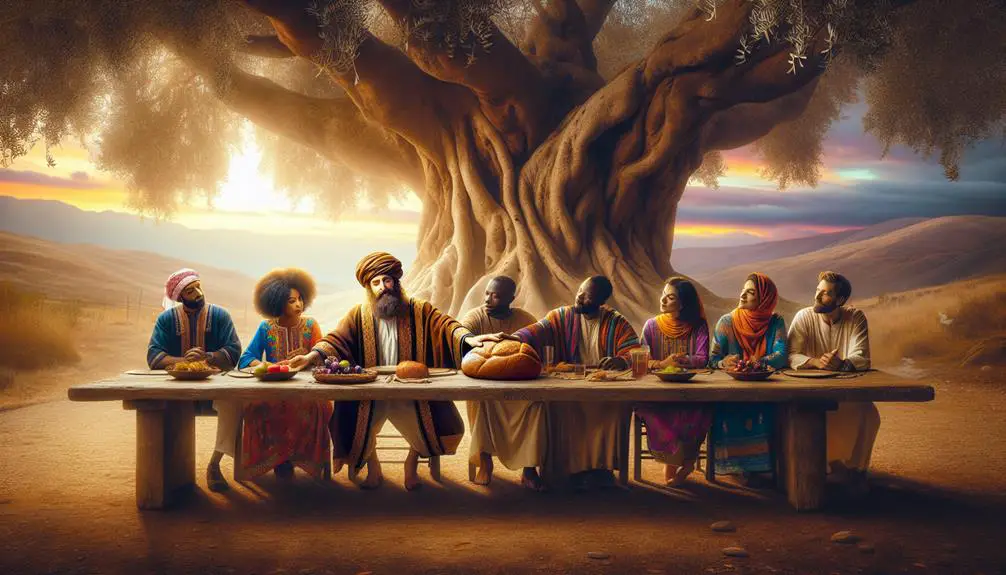
Throughout His ministry, Jesus frequently expressed gratitude, exemplifying the profound role that thanksgiving plays within the spiritual life and teachings of Christianity. This theme of thanksgiving, particularly evident in the narratives of the Miracle Feeding and Gratitude Prayers, underscores Jesus's commitment to acknowledging the Father's provision and blessings. By analyzing these instances, one can glean deeper insights into the significance of gratitude in the Christian faith.
- Miracle Feeding: In the accounts of feeding the 5,000 and later the 4,000, Jesus demonstrates thanksgiving before the miraculous multiplication of loaves and fishes. Here, gratitude precedes divine provision, suggesting that recognition and appreciation of God's potential blessings are fundamental to witnessing His power in action.
- Gratitude Prayers: Before raising Lazarus from the dead, Jesus prays, thanking God for hearing Him, highlighting the confidence in His ongoing relationship and communication with the Father. This moment illustrates the integral role of thanksgiving in faith and prayer, reinforcing the belief in God's attentive presence.
- The Last Supper: During this pivotal event, Jesus gives thanks before breaking the bread and sharing the cup, symbolizing His body and blood. This act of gratitude, even in the face of impending suffering, emphasizes the importance of thanksgiving in Christian sacraments and rituals as a means of remembering and participating in the mystery of faith.
- Post-Resurrection Appearances: In His post-resurrection appearances, Jesus continues to give thanks, notably when breaking bread with the disciples at Emmaus. This reinforces the continuity of gratitude throughout His ministry, from beginning to end, as a consistent expression of faith and acknowledgment of God's providence.
These instances where Jesus gives thanks not only showcase the centrality of gratitude in His teachings but also serve as a model for believers, emphasizing the transformative power of thanksgiving in deepening one's spiritual life and relationship with God.
Paul's Letters of Gratitude

In the New Testament, Paul's epistles stand out for their frequent emphasis on gratitude, showcasing how this virtue underpins the apostle's theological reflections and pastoral advice. Paul's letters weave gratitude into the fabric of Christian life, advocating for it not merely as an individual practice but as a communal ethos that strengthens the body of believers. His epistles to the Thessalonians, Philippians, and Colossians, among others, punctuate this theme with clarity and depth.
Analyzing Paul's gratitude practices reveals a multifaceted approach. He expresses personal gratitude to God for his own salvation and calling (1 Timothy 1:12-14), for the faith and growth of his communities (Philippians 1:3-5), and for the support received from Christian brothers and sisters (Romans 16:3-4). However, Paul's emphasis extends beyond personal thankfulness to encourage a collective culture of gratitude within early Christian communities. This is particularly evident in his exhortations to give thanks in all circumstances (1 Thessalonians 5:18) and to sing psalms, hymns, and spiritual songs with gratitude in hearts to God (Colossians 3:16).
Paul's integration of gratitude practices into his epistolary discourse serves not merely as an expression of personal piety but as a foundational component of Christian identity and community appreciation. By framing gratitude as a communal and spiritual practice, Paul delineates a vision of Christian community marked by mutual support, acknowledgment of God's grace, and the fostering of a positive, resilient spiritual ethos. This, in turn, underscores the transformative power of gratitude in shaping Christian life and fellowship, positioning it as a central pillar of early Christian spirituality and community dynamics.
Frequently Asked Questions
Is There a Specific Thanksgiving Event or Celebration Directly Mentioned in the Bible Similar to the Modern American Thanksgiving Holiday?
The current inquiry seeks to establish whether the Bible directly references an event akin to the modern American Thanksgiving holiday, specifically highlighting its Pilgrim origins and association with harvest festivals.
Analytically, while the Bible recounts numerous instances of thanksgiving and feasts celebrating harvests, none precisely mirror the contemporary Thanksgiving observance with its specific historical backdrop and emphasis.
The concept of expressing gratitude through communal meals, however, is a recurring biblical theme.
How Do Biblical Teachings Influence the Way We Perceive and Celebrate Thanksgiving Today?
Biblical teachings deeply influence contemporary gratitude practices and the origins of Thanksgiving. Through an analytical lens, it becomes evident that principles of thankfulness and communal sharing, foundational in biblical scripture, permeate modern celebrations. These teachings advocate for reflection, generosity, and acknowledgment of blessings, shaping the ethos of Thanksgiving today.
This scholarly perspective underscores how ancient texts continue to mold collective expressions of gratitude, embedding a profound historical context into current observances.
Were There Any Instances of Fasting or Abstaining From Food as a Form of Thanksgiving in Biblical Times?
In the context of fasting rituals and the significance of abstinence, it is noteworthy to mention that instances of fasting or abstaining from food in biblical times were not typically associated with thanksgiving. Instead, these practices were more commonly linked with penitence, mourning, or spiritual preparation.
The analytical examination of scriptural texts reveals that thanksgiving was usually expressed through acts of worship, prayer, and offering, rather than through abstinence or fasting.
How Do Different Religious Traditions Interpret the Concept of Giving Thanks According to the Bible Outside of the Mentioned Sections?
In exploring the interpretation of giving thanks across different religious traditions according to the Bible, it is essential to analyze the Gratitude Psalms and Harvest Festivals.
These elements embody a profound expression of thankfulness, transcending mere ritual to encapsulate a broader, spiritual acknowledgment of divine benevolence.
This analytical approach reveals a shared theological foundation, highlighting how these practices serve as universal expressions of gratitude within a diverse religious landscape.
Can the Act of Giving Thanks in the Bible Be Linked to Specific Miracles or Divine Interventions?
In biblical narratives, the act of giving thanks often precedes or follows significant manifestations of divine intervention. This correlation underscores a profound relationship between miracle recognition and expressions of divine gratitude.
Analytically, these instances serve not only as acknowledgments of God's intervention in human affairs but also as a theological framework that emphasizes the importance of gratitude in fostering a deeper spiritual connection.
Through this lens, thanksgiving becomes a pivotal response to witnessing or receiving divine acts.
Conclusion
In the tapestry of biblical narratives, the threads of gratitude and thanksgiving are intricately woven, manifesting across various epochs and figures. From the Old Testament's First Fruits Offering to the New Testament's expressions of gratitude by Paul, these accounts underscore a fundamental ethos of thanksgiving.
This tradition of gratitude, transcending mere ritual, embodies a profound acknowledgment of divine providence and blessings. Thus, the biblical stories of thanksgiving, rich in symbolism and meaning, continue to inspire a timeless reverence for the sacred act of giving thanks.

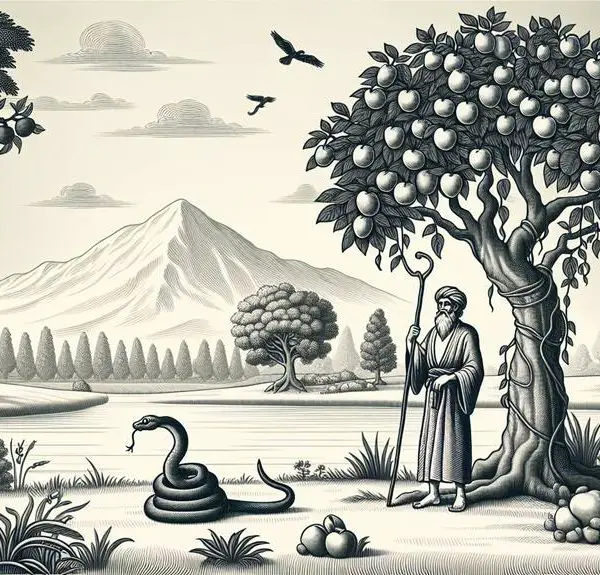

Sign up